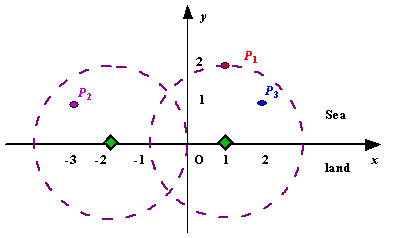Radar Installation
Time Limit : 2000/1000ms (Java/Other) Memory Limit : 20000/10000K (Java/Other)
Total Submission(s) : 93 Accepted Submission(s) : 46
Problem Description
Assume the coasting is an infinite straight line. Land is in one side of coasting, sea in the other. Each small island is a point locating in the sea side. And any radar installation, locating on the coasting, can only cover d distance, so an island in the sea can be covered by a radius installation, if the distance between them is at most d.
We use Cartesian coordinate system, defining the coasting is the x-axis. The sea side is above x-axis, and the land side below. Given the position of each island in the sea, and given the distance of the coverage of the radar installation, your task is to write a program to find the minimal number of radar installations to cover all the islands. Note that the position of an island is represented by its x-y coordinates.

Figure A Sample Input of Radar Installations
We use Cartesian coordinate system, defining the coasting is the x-axis. The sea side is above x-axis, and the land side below. Given the position of each island in the sea, and given the distance of the coverage of the radar installation, your task is to write a program to find the minimal number of radar installations to cover all the islands. Note that the position of an island is represented by its x-y coordinates.

Figure A Sample Input of Radar Installations
Input
The input consists of several test cases. The first line of each case contains two integers n (1<=n<=1000) and d, where n is the number of islands in the sea and d is the distance of coverage of the radar installation. This is followed by n lines each containing two integers representing the coordinate of the position of each island. Then a blank line follows to separate the cases.
The input is terminated by a line containing pair of zeros
The input is terminated by a line containing pair of zeros
Output
For each test case output one line consisting of the test case number followed by the minimal number of radar installations needed. "-1" installation means no solution for that case.
Sample Input
3 2
1 2
-3 1
2 1
1 2
0 2
0 0
Sample Output
Case 1: 2
Case 2: 1
题目大意:
先输入两个数字n与d,n代表小岛的个数,d代表卫星所能覆盖范围的半径,接下来n行数字,代表n个小岛的坐标,卫星安置在x轴上,求最少需要几个卫星,能够覆盖所有的小岛
思路:
以小岛为中心,以卫星半径为半径画圆,该圆与x轴所交的弦即为可放置卫星的地方,若想放置卫星最少,则应放置在右边界地方,请仔细思考
1 #include <stdio.h> 2 #include <algorithm> 3 #include <math.h> 4 using namespace std; 5 struct qj 6 { 7 double l, r; 8 }b[1110];//记录可以放置卫星的地方的左右区间 9 bool cmp(qj a, qj b) 10 { 11 if(a.r == b.r) 12 return a.l > b.l; 13 return a.r < b.r; 14 }//自定义排序,按照右区间从小到大排列,若右区间相等,则按左区间从大到小排列 15 int main() 16 { 17 double x, y; 18 double d,temp; 19 int i, n, count, num=1; 20 while(~scanf("%d %lf", &n, &d), n&&d) 21 { 22 for(i = 0; i < n; i ++) 23 { 24 scanf("%lf %lf", &x, &y); 25 b[i].l = x - sqrt(d*d - y*y);//放置卫星的地方的左区间 26 b[i].r = x + sqrt(d*d - y*y);//放置卫星地方的右区间 27 } 28 sort(b, b + n, cmp); 29 count = 1; 30 temp = b[0].r; 31 for(i = 1; i < n; i ++) 32 { 33 if(b[i].l > temp)//判断两个区间是否有交叉 34 { 35 temp = b[i].r; 36 count++; 37 } 38 } 39 printf("Case %d: %d ", num++, count); 40 } 41 return 0; 42 }